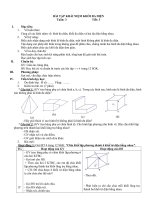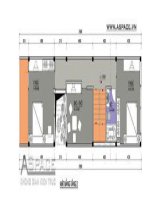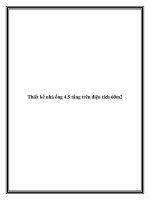Global spec webinar 4 5 13 onsite solutions 0913
Bạn đang xem bản rút gọn của tài liệu. Xem và tải ngay bản đầy đủ của tài liệu tại đây (1.37 MB, 29 trang )
Test It, Don’t Change It
On-site Oil Analysis Solutions
Candice Brown, Spectro Incorporated
Machine failures
are very costly…
sometimes spectacular,
…and the lubricant is a
common cause of failure
2
Mechanical causes of machine failure- oil wetted components
70% of equipment downtime is due to surface degradation - Corrosion and Wear
20%
ROOT CAUSES
MECHANISM
CORROSION
water or other corrosive fluids
chemically attacks and
weakens metal surfaces
ABRASION
50%
wear
ADHESION
FATIGUE
ASLE Bearing Workshop, Rabinowicz, 1981
CAUSES
Water in oil, degraded oil, process
contamination, coolant, condensation…
3-Body Cutting damage from
Abrasive particles in oil, dirt, secondary
abrasive particles between two
wear, process contamination…
moving surfaces
Damage from metal surfaces
dragging over each other
Inadequate lubrication- low viscosity oil
or no oil, high temperature, excess load,
slow machine speed…
Damage from micro-cracks
caused by cyclic loading
Misalignment, imbalance, improper fit or
assembly, secondary damage…
3
Machine condition monitoring technologies
Industrial requirements for
machine condition
monitoring
•
•
•
Non-intrusive
measurements
Early detection to
reduce cost
Multiple technologies
for complete
assessment
Oil
Analysis
Vibration
Alignment
Analysis
Condition
Monitoring
Technologies
Infrared
Thermography
Ultrasound
Motor Circuit
Evaluation
Oil condition monitoring
is part of a
comprehensive
Predictive Maintenance
program.
4
Complementary: vibration and oil analysis
Proactive maintenance -prevents failure
Onset
of failure
Reduce dynamic loads to extend
machinery life & reduce fatique
•
•
•
•
Misalignment, imbalance, resonance,
% life
looseness and incorrect assembly cause
remaining
mechanical damage
Dust and other particles cause abrasion
Water and other fluids cause corrosion
Inadequate lubrication causes adhesion
Proactive
~ 90% of component life
in
proactive period
Operating hours
Eliminate root causes with proactive maintenance. No damage= long component life
5
Complementary: vibration and oil analysis
Predictive maintenance -failure has begun
% remaining life
onset
Predictive
•
~ 10% of component
life in
Predictive period`
Identify defects with vibration
analysis (overall method and advanced
analysis techniques such as PeakVue®)
failure
Operating hours
Detection of incipient/initial damage
Monitor and trend from onset to predict
failure
•
Monitor and trend key oil analysis
parameters critical to machinery
health to establish alarm levels
Eliminate root causes with proactive maintenance. No damage= long component life
6
In-service oil analysis
Oil analysis provides detailed information on the
causes of surface degradation of lubricated
machinery and:
•
•
•
•
Reduces unexpected downtime
Conserves oil
Reduces maintenance costs
Reduces environmental impact of waste oil disposal
– oils and filters not replaced before end of service life
7
A comprehensive oil analysis program answers
Is it the right oil?
Is the oil still clean?
Viscosity, additives
No dirt, dust
Is it still dry?
Is it still fit for use?
Water, liquids
Viscosity, oil chemistry
Is the machine still OK?
Free of abnormal wear debris
How best to address
these?
8
Oil analysis provides actionable information
TrivectorTM
•
Wear
–
•
Contamination
–
–
–
•
Particles in oil from normal and
abnormal machinery wear
Dust/dirt accelerates wear
Water, glycol
Process fluids
Change filter?
Dry oil?
Change oil?
Tear Down?
Chemistry
– Oil degradation
– Additives
& Physical: Viscosity
Let’s address each of these…
Trivector is a trademark of Emerson CSI
9
Oil analysis measurements–laser based particle counter
Wear
Contamination
Technique Instrument
Component
wear
Particulate
contamination:
• Quantity & size
distribution
• ISO codes
Laser light
blockage
Component
wear
•
Direct
imaging laser.
•
Automatic
shape
classification
Quantity & size
distribution
ISO codes
Good for dark
and opaque
oil.
10
Oil analysis measurements– elemental analysis
Wear metals
Contaminants
Chemistry
Additives
Technique / Instrument
Rotating Disk Electrode (RDE)
Spectroscopy ( or ICP or XRF)
Elemental analysis
Aluminum
Boron
Barium
Cadmium
Silicon
Boron
Chromium
Sodium
Calcium
Copper
Manganese
Iron
Phosphorus
Lead
Potassium
Magnesium
Zinc
Commonly analyze
23 Elements
Molybdenum
Nickel
Silver
Tin
Titanium
Vanadium
11
Oil analysis measurements– abnormal wear and ferrography
Wear
Technique
Large Ferrous wear
measurement
Fe Index
Time resolved dielectric
Instrument
Magnetometer
PQ
Automatic shape
classification of wear
Laser Net Fines direct
imaging laser
Wear debris analysis /
Ferrography
Root cause analysis
from shape (3D), size,
color
Separation (patch, slide)
and interpretation of
wear and contaminant
particles
WDA software
12
Oil analysis measurements– water
Contamination
Technique
Dissolved water
Wet chemistry Karl
Fisher titration per
ASTM D6304
Free & emulsified
water
Instrument
Benchtop titrator
Water
Centrifuge per
ASTM D95
Centrifuge
Water increases
corrosion and leads to
adhesive wear
Quantitative
measurement of
dissolved water, ppm
Detects free and
emulsified water
Handheld Direct IR with
Integrated oil library
Handheld IR spectrometer
13
Oil analysis measurements– other liquids
Contamination
Technique
Instrument
Glycol
Fourier Transform
Infrared Spectrometer
Bench top IR spectrometer
Cross contamination
Or
Wrong oil
Direct Infrared
Spectrometer
Handheld IR spectrometer
Change in dielectric via RC
circuit discharge of test
chamber
Dielectric test port
14
Oil analysis measurements– other liquids
Contamination
Technique
Instrument
Glycol
Fourier Transform
Infrared Spectrometer
Bench top IR spectrometer
Cross contamination
Or
Wrong oil
Direct Infrared
Spectrometer
Handheld IR spectrometer
Change in dielectric via RC
circuit discharge of test
chamber
Dielectric test port
15
Oil Analysis measurements– chemistry
Oil degradation
forms acidic byproducts that
lead to
corrosion,
varnish
formation,
sludge.
Must have
TAN/TBN, or
dielectric, to
know if oil
chemistry still
fit for use
TAN/TBN
Chemistry
Technique
TAN, per ASTM D664
TBN, per D4739 or
D2896.
Wet chemistry titration
reagent with solvent rinse
Trained technician
Instrument
Titrator
TAN, oxidation, water
for machinery oils
TAN/TBN
Dielectric
Handheld, Direct IR w/ oil
reference library
TBN, nitration,
sulfation,oxidation,
soot for engine oils
Additive depletion
Measures changes in
overall oil chemistry
(chemical polarity)
Handheld IR spectrometer
Change in dielectric via
RC circuit discharge of
test chamber
Dielectric test port
16
Oil analysis measurements– viscosity
Contamination
Chemistry
/
Physical
Technique
Wrong oil
Proper
viscosity
Falling or Rolling ball viscometers,
Resistance to flow
measured at ambient
temperature
Dynamic
viscosity
Manual,
kinematic
Kinematic
40C
Wrong oil
Proper
viscosity
Wrong oil
Proper
viscosity
Instrument
ASTM D445 stopwatch
measurement
Resistant to flow under gravity,
transit time down capillary
channel at fixed 40C temperature.
Portable
17
Challenges with industrial oil analysis
Outsourcing Oil Analysis
•
Timeliness of oil analysis report for
maintenance actions can be an issue
–
–
•
•
Loss of ‘mindshare’
Outdated information
Hard to integrate into other modern
PdM techniques such as Vibration
and Thermography
Oil suppliers free oil analyses are
rarely comprehensive
18
Challenges with on-site oil analysis
Effective on site oil analysis program
• Work process
• Equipment
• Training
Let’s look at some case studies…
19
Cost justification for industrial oil analysis
Documented case histories and cost savings on-site oil analysis to monitor a wide
range of industrial machinery. Realistic Return on Investment: 500%+
Reduce oil consumption
LESS OIL USED
“Test it, don’t change it”
Defer maintenance
Eliminate reactive maintenance
Proactive CONTAMINATION CONTROL
Keeping oil clean, dry, and fit for use
Trend FAILURE PROGRESS
Predictive vibration & oil analysis
20
Refinery lubrication & oil analysis program
Measurable results:
30% less failures
Savings of $2.1M/year at
$6,500/incident average cost
Year 1
Year 2
Year 3
Year 4
21
Assembly plant
Oil analysis program justification:
Gearbox failure caused 27 hour
production outage.
Results:
•
•
•
•
•
•
•
•
•
$1.6 Million savings in 28 months
2 month payback period
738% ROI based on 20% IRR
Improve Lubrication Quality
Reduced Machinery Wear
Extended Oil Change Intervals
Reduced Oil Disposal Cost
Reduced Oil Sample Cost
Simple Cost Avoidance Methods
22
Military On-Site Analysis
•
Comparison to Lab Results
– Test kits showed issues with TBN Measurements
– FluidScan operates independently of manufacturer’s specs
• Higher accuracy=higher confidence=higher participation
•
Significant Savings in Time & Money
– 10-15 Man Hours saved per week
• Saved labor costs=quicker payback
– No Annual Recalibration Costs
– No Hazmat Costs
23
There are some challenges implementing on-site oil analysis
On Site Oil Analysis
•
•
•
•
Possible lack of on site oil expertise
Perceived difficulty of oil analysis
Integration of data
Logistics management of waste disposal,
solvent handling and training
24
Addressing the challenges of on-site oil Analysis
Possible lack of on site oil expertise
• Simple to use device with built in lubricant reference
library and preset, adjustable alarm limits
• Correlates to lab FT-IR and Water/TAN/TBN titration
Perceived difficulty of oil analysis
• One drop of oil to test, One minute for results
• Immediate & actionable information
Handheld Infrared Oil Analyzer
Helps determine if in-service oil is fit
for use.
Measures degradation of the oil
chemistry, and contamination by
other liquids such as water.
Logistics management of waste disposal, solvent handling
and training
• Solvent free
• Easy to use flip top cell
25









